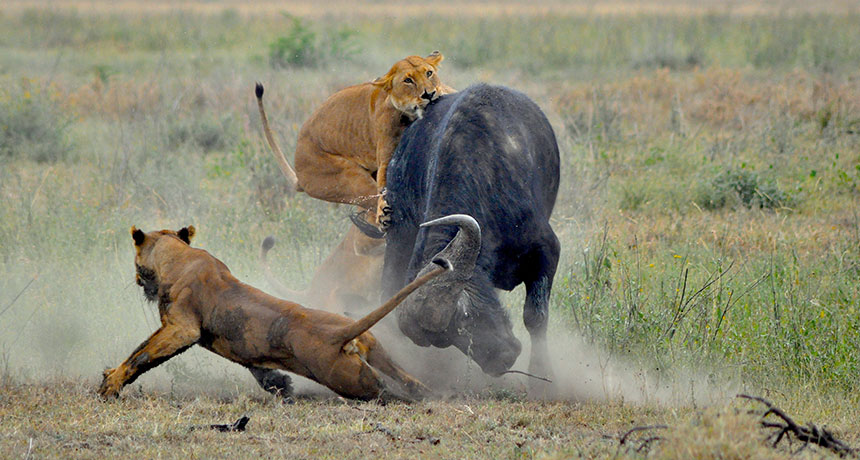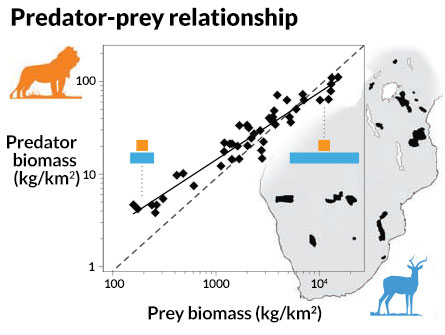
BITE CLUB Regardless of where an ecosystem is, the predators and prey appear to follow roughly the same rule in their relative rates of increase, a new study says.
Amaury Laporte
On land or sea, when the zebras, gazelles or even plankton fruitfully multiply, their predators’ abundance doesn’t increase quite as much, a new analysis proposes.
This predator-prey relationship— predators increasing at a particular rate that’s less than that of their prey — turned up in studies of the total mass of the top carnivores in Africa’s parks, says study coauthor Ian Hatton of McGill University in Montreal. And the same relationship seems to apply in lakes, oceans and on other continents for top hunters as different as lions and zooplankton, Hatton and colleagues report in the Sept. 4 Science.
The math describing such relationships, known as a power law, incorporates an exponent (power) to relate the change in one factor (predator biomass) to another (prey biomass). In this case, the exponent is about 0.75, indicating that the predator biomass increases less rapidly than prey biomass.
What’s “weird,” Hatton says, is that the relative rate of predator growth to prey growth observes the same math, or ¾ power law, that physiologists use to estimate relationships at just the species level, such as how basal metabolism changes with a species’ body size.
Maybe the echo of these physiology rules is just coincidence, Hatton says. But there’s much to discover about what causes the power law relationship.
The observed predator-prey relationship grew out of Hatton’s Ph.D. work, which started with studying predators and prey in parks in Africa. Hatton burrowed into archived data on the five dominant predators (lions, leopards, cheetahs, hyenas and wild dogs) and the hoofed grazing animals that make up their major prey. With 190 studies from 23 protected natural areas, he and his colleagues calculated the total amount of carnivore flesh in a park and the total amount of prey flesh that supported it.

When the ¾ relationship jumped out, the researchers wondered what such an analysis would reveal in other communities. Data weren’t available in such detail elsewhere, but Hatton and colleagues found just about the same ¾ power law predicting how tigers increase with their main prey in protected areas in Southeast Asia and how wolves increase with prey in North America. Enough ecologists have contemplated the world of lake and oceanic plankton to produce data on how zooplankton increase with the phytoplankton that provide their food. And again, the relationship comes close to the ¾ power law.
Ryan Hechinger of Scripps Institution of Oceanography in San Diego, an ecologist not involved in the research, says he’s still digging into it to examine the methods in this study. But so far, it looks as if Hatton and his colleagues “have uncovered a pervasive pattern characterizing a wide range of ecosystems,” he says. Now he’s thinking about why the pattern occurs.
Hatton says that just what causes this relationship isn’t clear, but he suspects that the basic productivity of an ecosystem lies at the heart of it.
The echo of the physiology laws intrigues Just Cebrian of Dauphin Island Sea Lab on the Alabama coast. It could, of course, be coincidence, he says. However, he muses that these big-scale totals of predator and prey flesh “could be subject to the same metabolical and physiological constraints” as are the growth and size changes of individual species.





